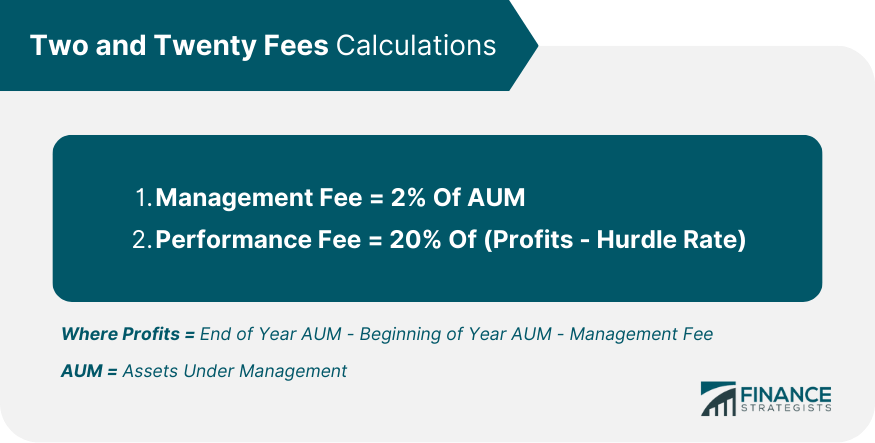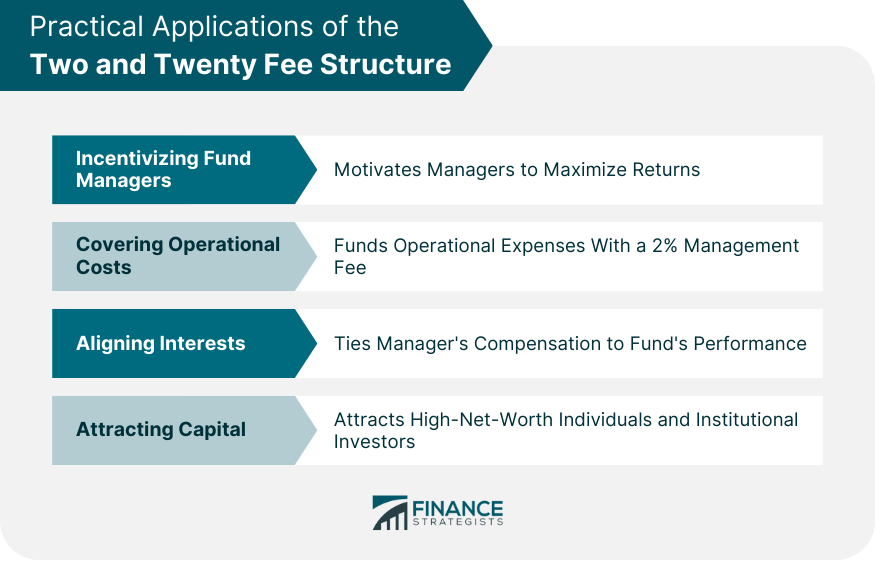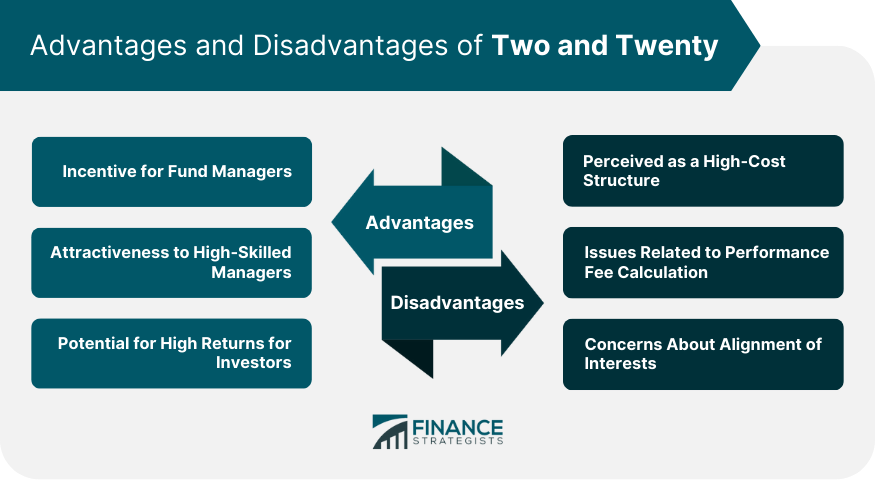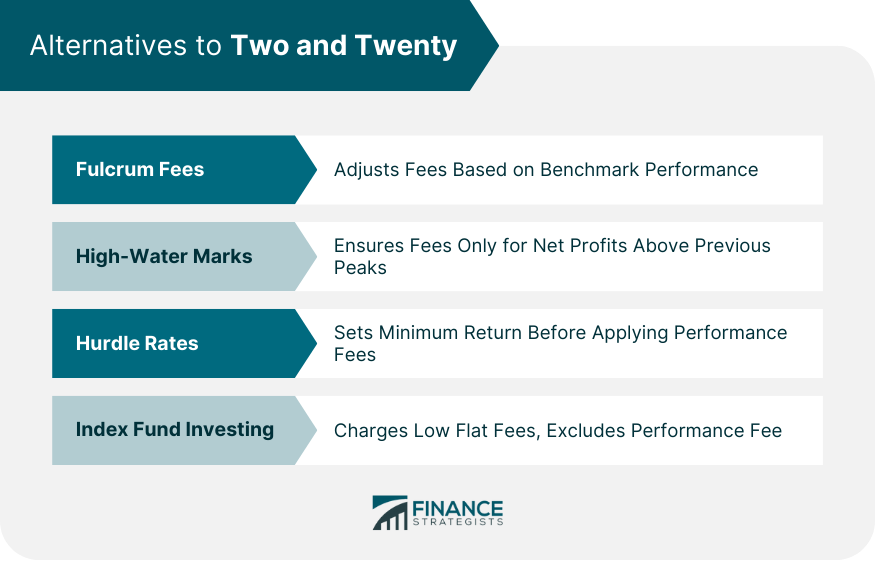The two and twenty fee model is prevalent in the hedge fund industry. The "two" denotes a 2% management fee applied to the total assets under management (AUM) collected annually, irrespective of the fund's performance. It's primarily designated for operating expenses. The "twenty" signifies a performance or incentive fee, usually 20% of the fund's profits exceeding a certain benchmark or hurdle rate. This fee only applies when the fund generates a profit, motivating fund managers to yield superior returns. Despite its commonplace usage, this model has faced criticism due to the substantial costs it can incur, particularly when the funds underperform. Recently, many funds have adapted to a more investor-friendly, flexible fee structure. Understanding this fee structure is crucial as an investor because it directly affects your potential net return and the overall cost of investing in hedge funds. To fully comprehend the two and twenty fee structure, it is essential to understand how the management and performance fees are calculated. Here's a breakdown of how each fee is determined: The management fee in the two and twenty structure is relatively simple to calculate. It is typically a fixed percentage, commonly 2%, of the total assets under management (AUM) for the year. The calculation is as follows: Management fee = 2% of AUM For instance, if a hedge fund manages $100 million in assets, the annual management fee would be: Management fee = 2% of $100 million = $2 million This fee is often deducted quarterly and is independent of the fund's performance. The " Twenty " performance fee in "Two and Twenty" is more complex. This fee is typically 20% of the fund's profits above a particular benchmark or "hurdle rate." To calculate the performance fee, you first need to calculate the profits: Profits = End of year AUM - Beginning of year AUM - Management fee If the calculated profits exceed the hurdle rate (if one exists), the performance fee is then: Performance fee = 20% of (Profits - Hurdle rate) Suppose the same fund ends the year with $115 million in assets. The profits would be: Profits = $115 million - $100 million - $2 million = $13 million If there is no hurdle rate, the performance fee would be: Performance fee = 20% of $13 million = $2.6 million Therefore, the total fees paid to the hedge fund would be the sum of the management and performance fees, which in this case would be $4.6 million. Please note that these calculations can vary slightly based on individual hedge funds' specific agreements and structures. The two and twenty fee structure is predominantly employed in the hedge fund industry and, to a lesser extent, private equity firms and certain other types of investment vehicles. The structure serves a number of practical purposes: Incentivizing Fund Managers: The structure is designed to motivate fund managers to generate the highest possible returns. Fund managers are incentivized to outperform the market since a substantial portion of their earnings comes from the performance fee. Covering Operational Costs: The management fee, usually 2%, provides a steady income stream that helps cover the fund's operational expenses, including administrative costs, research costs, salaries, and office space. Aligning Interests: The performance fee aligns the interests of fund managers and investors. Since the manager's compensation is directly tied to the fund's performance, they are financially incentivized to act in the best interests of their investors. Attracting Capital: The potential for high returns can attract investors willing to pay these fees. This structure particularly appeals to high-net-worth individuals and institutional investors seeking aggressive growth strategies. The two and twenty structure incentivizes fund managers to maximize returns since their compensation is directly tied to the fund's success. The promise of a significant payday can drive fund managers to work diligently and creatively to enhance fund performance. The potential for high earnings can attract top talent to the fund management role. Skilled managers are more likely to be drawn to roles where their compensation is tied to their performance, which can result in better outcomes for investors. Investors may benefit from the drive and expertise of motivated fund managers. As the fund managers work to increase the fund's profitability to enhance their compensation, investors stand to reap the benefits of these high returns. The two and twenty structure can be perceived as costly, particularly during lower returns. Investors may question the value of paying high fees when returns are not commensurate. Critics point out that performance fees are often calculated without accounting for risk. Fund managers may be incentivized to take on excessive risk to pursue high returns. While the two and twenty structure is designed to align the interests of fund managers and investors, it can sometimes create conflicts. For example, fund managers may favor investments that offer the potential for higher short-term returns at the expense of long-term stability. While two and twenty is a commonly used fee structure in the hedge fund industry, it has been criticized for its high costs. Therefore, several alternatives have been developed over time: Fulcrum Fees: This is a performance-based fee structure where the management fee adjusts depending on the fund's performance relative to a benchmark. High-Water Marks: While not an alternative to two and twenty per se, high-water marks are a feature that can be added to the fee structure to protect investors from paying performance fees for poor long-term performance. Hurdle Rates: Similar to high-water marks, a hurdle rate is a minimum return that a fund must achieve before the manager can collect a performance fee. Index Fund Investing: For investors seeking lower fees, index funds often charge a flat fee well below 1% and no performance fee, as these funds simply aim to replicate the performance of a specific market index. The two and twenty model is a widely employed fee structure in hedge funds and other investment vehicles. It entails a 2% annual management fee, calculated on total assets under management (AUM), plus a 20% performance fee levied on profits above a specific benchmark. This structure motivates fund managers to generate substantial returns, benefiting investors and attracting top talent to the fund. Nevertheless, it's often considered costly, particularly when the fund's performance doesn't justify the fees. Understanding the intricacies of this fee model, including its calculation and practical applications, is crucial for anyone considering hedge fund investments. It's equally vital to be aware of the alternatives to this model, such as fulcrum fees and index fund investing. This enables investors to choose a fee structure that best suits their risk tolerance and investment goals, optimizing their potential net returns.What Is the Two and Twenty Fee Model?
Calculating the Two and Twenty Fee Structure
Calculating the Management Fee
Calculating the Performance Fee

Practical Application of Two and Twenty

Advantages of Two and Twenty
Incentive for Fund Managers
Attractiveness to High-Skilled Managers
Potential for High Returns for Investors
Criticisms of Two and Twenty
Perceived as a High-Cost Structure
Issues Related to Performance Fee Calculation
Concerns About Alignment of Interests

Alternatives to Two and Twenty
If the fund outperforms the benchmark, the management fee increases; if it underperforms, the fee decreases.
A high-water mark ensures that performance fees are only paid on net profits above the highest previously recorded value of the fund.
For instance, if a 5% hurdle rate is set, a fund must generate returns exceeding 5% before performance fees are collected.
Conclusion
Two and Twenty FAQs
Two and twenty is a common fee structure used by hedge funds, private equity firms, and venture capital funds. The 'two' represents a 2% annual management fee charged on the total assets under management. The 'twenty' stands for a 20% performance fee, which is charged on any profits made by the fund.
The two and twenty fee structure incentivizes fund managers to perform well because a significant part of their income (the 20% performance fee) comes from their profits. Regardless of fund performance, it also provides a steady income (the 2% management fee).
Critics argue that two and twenty can be a high-cost structure for investors, especially if the fund fails. There are also concerns about the alignment of interests, as managers might take excessive risks to boost performance and earn the 20% fee.
Alternatives to two and twenty include fee structures with lower management fees, hurdle rates (where the performance fee only kicks in after a certain rate of return is achieved), and high-water marks (where the performance fee is only charged on new profits, not on recouped losses).
The two and twenty fee structure has been under pressure recently due to increased competition and regulatory scrutiny. Some funds have lowered their fees or adopted alternative structures in response to these pressures. However, two and twenty remains a common fee structure in the industry.
True Tamplin is a published author, public speaker, CEO of UpDigital, and founder of Finance Strategists.
True is a Certified Educator in Personal Finance (CEPF®), author of The Handy Financial Ratios Guide, a member of the Society for Advancing Business Editing and Writing, contributes to his financial education site, Finance Strategists, and has spoken to various financial communities such as the CFA Institute, as well as university students like his Alma mater, Biola University, where he received a bachelor of science in business and data analytics.
To learn more about True, visit his personal website or view his author profiles on Amazon, Nasdaq and Forbes.














